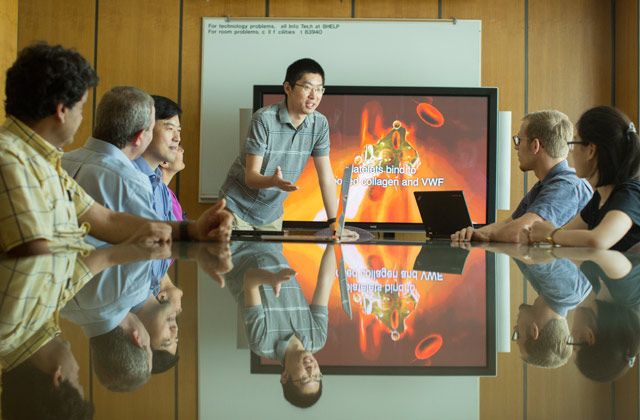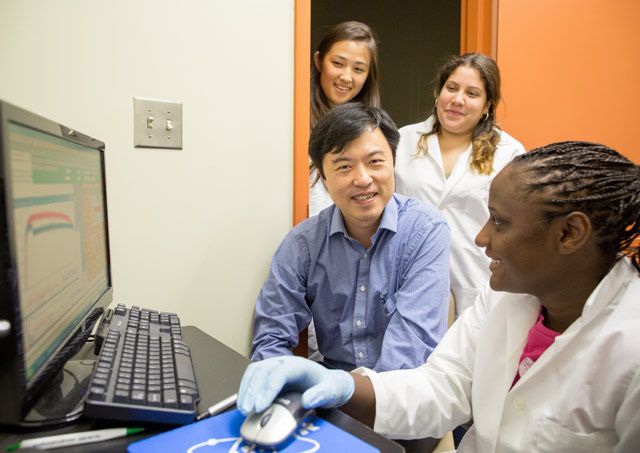From left: Professors Xiaohui (Frank) Zhang, Alparslan Oztekin, Xuanhong Cheng and Edmund Webb III and their students study vWF, a shapeshifting protein that controls the body's ability to heal its own wounds—and may allow clinicians to target drug delivery in the fight against heart disease. (Photo by Douglas Benedict/Academic Image)
There’s a mechanical sensor journeying silently through your blood, ready to spring into action at any sign of major bleeding. This first responder molecule, known as Von Willebrand Factor (vWF), latches on to the lining of damaged blood vessels and grabs nearby platelet cells, helping them to clot off the bleeding.
“vWF’s singular ability to sense changes in hydrodynamic flows is not completely understood,” says Xiaohui (Frank) Zhang, assistant professor of mechanical engineering and mechanics, who leads a Lehigh team exploring its behavior. “While it can be a life-saver in cases of physiological injury, vWF can make things worse by activating in certain pathological situations, such as a narrowed artery which, if closed, can trigger a stroke.”
Knowing the mechanisms that actuate and disable vWF could someday help researchers design custom molecules that could safely deliver drugs to the precise location of a dangerous clot, narrowed blood vessel, or other cardiovascular emergency – a potential gamechanger in the fight against heart disease.
“That’s our focus,” says Edmund Webb III, associate professor of mechanical engineering and mechanics. “Can we engineer a molecule to respond and preferentially deliver an active drug right on target? Researchers have yet to develop controlled-release medications that respond to biochemical conditions in the body; the next best thing could be drug carriers that respond to mechanical forces as vWF does.”
Understanding the mechanical triggers of vWF could also help to treat clotting disorders known as Von Willebrand disease, in which clots either don’t form properly or emerge spontaneously in the body in the absence of bleeding. These conditions affect two out of every 100 persons.
Zhang, Webb, and fellow co-principal investigators Xuanhong Cheng and Alparslan Oztekinare completing the first of a 3-year project aimed at unlocking the mysteries of vWF. Supported by the National Science Foundation, the team is using an array of experimental and computational techniques, focused at the molecular level and at the scale of blood vessels, to explore how vWF responds to physical events, such as bleeding, and pathological conditions, such as arteriosclerosis.
Von Willebrand Factor is a complex collection of amino acids that normally flows in the bloodstream scrunched up as a globule about .25 microns in diameter. In this configuration, the molecule’s active regions are shielded from contact with blood vessel walls or platelet cells. In the right circumstances, the protein unwinds into a strand about 40 times as long.
“It’s a huge molecule,” says Zhang. “In a typical cell there are millions of molecules, yet vWF is the same length as the diameter of a cell.”
Wound, heal thyself
“Under normal conditions in the body,” says Cheng, P.C. Rossin Associate Professor of materials science and engineering, “blood undergoes laminar flow where molecules flow in parallel down the interior of a vessel. But when a major vessel is cut, it causes turbulent flow and chaotic motion.”
“When that vessel is cut,” Webb continues, “the endothelial cells on its inner surface are severed and a layer of collagen is exposed to the blood. The pressure pumping blood through the cut is also significantly higher than the surrounding atmosphere, and blood flowing through the area speeds up by as much as tenfold.”
The acceleration and sheer forces trigger vWF in the bloodstream to unwind and extend. In the process, a region of the molecule known as A3 becomes “sticky” and latches on to the exposed collagen layer. At the same time, a nearby region on the molecule known as A1 grabs platelets from the blood as they flow past. In this way, the extended vWF becomes the glue that binds platelets together and plugs the wound.
According to Cheng, vWF’s shape-shifting behavior is not uncommon, but it does exhibit some unexpected properties that are capturing the team’s interest.
“Most of the time when a protein transitions from a globular form to extended form it denatures – it loses function,” she says. “Yet vWF has no known function when it is contracted, and only goes to work when it is extended.
“And when you increase a fluid’s flow, a hydrodynamic lift effect would normally move globule polymers in the fluid away from the surface of the channel,” Webb says. “Until now, it’s been a mystery why the adhesion of vWF goes up with increased flow.” The researchers believe that, because vWF only reveals its active regions when extended, it adheres to the vessel before the increasing flow can peel it away.
Researchers have generally understood the mechanism by which vWF acts. However, to use its secrets to design drug carrier molecules, the Lehigh team believes that it is crucial to know exactly how vWF responds to specific flow conditions, and how it deactivates.
Zhang has been studying this mysterious molecule for years. As a postdoctoral fellow at Harvard Medical School in 2009, Zhang and a team including his mentor, Timothy Springer, proved that vWF has “a safety factor,” a section known as A2 that, when extended, reacts with an enzyme called ADAMTS13 to cleave the molecule, rendering it harmless. Otherwise, healing a simple cut could cause an ever-growing clot that would soon block the entire vessel.
Today, Zhang is measuring the precise energies needed to trigger the unwinding of vWF using a technique known as optical tweezers, which uses a laser to generate a tiny force to grab and manipulate tiny molecules.
In his lab, Zhang and his students attach a small segment of vWF to a collagen layer, then grab the molecule and pull them apart, watching the strand deflect like a rubber band. “Using the optical tweezers we can stretch it slowly and measure the force [required to break the bond] to a very high resolution,” Zhang says. The experiment also allows precise measurement of the length of the molecule.
Zhang pulls on the vWF molecule at various rates, revealing a distribution of energies required to break the bond in different flow conditions. This energy landscape, as Webb calls it, is integral to developing a computer simulation of the molecule.
This dynamic approach is important because how a protein functions depends on how it folds and unfolds, not just on its atomic sequence, Cheng says.
“We are also trying to find out which part of the vWF molecule plays roles in the sensory function,” Zhang says. “We see different forces as we add different sections of the molecule,” he says.
Zhang predicts that this array of results will allow him to determine which section of the molecule is responsible for activating vWF. He hypothesizes that a section known as the D-prime D3 assembly is at work, but results so far have been inconclusive.
The energy landscapes revealed by Zhang’s experiments feed directly into the computer models being developed by Webb and Oztekin, professor of mechanical engineering and mechanics.
“The development of truly robust computer models, based on initial experimental results, will allow us to get ahead of the lab experiments,” Webb says.
Much of Webb’s research focuses on molecular and atomic scale models of interfaces, in this case the torn cell wall that facilitates contact between vWF and collagen.
Oztekin’s expertise in fluid dynamics adds critical detail to the model, offering descriptions of the interaction between molecules and the background flow, and how each bead in the molecule changes the flow field for subsequent sections.
“These models are very compute intensive, and the math is very complex,” Webb says. “It has been invaluable to have both of our perspectives at the table.”
The team has published a model of the molecule’s behavior in the bloodstream that has become generally accepted by the research community. Other researchers have made attempts at the more difficult problem of modeling the vWF-collagen interaction -- without the benefit of Zhang’s real-world results. The team recently submitted a paper for review that proposes a model for this process.
“We feel we are the first to have taken our numbers from experiments rather than educated guesses,” Webb says. “It gives us a closer connection to the real physical system.”
That connection will be strengthened by Cheng’s work to validate the computational results. In her lab, Cheng designs and fabricates microchannel environments that simulate conditions in the bloodstream. The body has large vessels, such as the aorta, that are three orders of magnitude larger than the tiniest capillaries, each with unique flow geometries, she says.
Using a technique similar to that used to manufacture computer chips, Cheng carves very small features into sheets of transparent polymer small enough to be observed under an optical microscope. The behavior of blood in small and large vessels is well known, she says, “so we can design the channel dimensions and geometry to give us the flow field we want to study.”
Tagging vWF samples with fluorescent dye, Cheng can observe the flow of molecules under the microscope, measuring how many of the balls extend at given flow rates. She can also coat the microchannels with a collagen like that inside damaged vessels, to describe how vWF behaves differently when bleeding occurs. Eventually she will study how the shortened and elongated molecules that cause Von Willebrand diseases respond in the same conditions.
“Being part of a project that includes experimental work and simulation at both molecular and systemic scale is also a benefit to our graduate students,” Cheng says.
Speaking of the students involved in the project, Webb says it is beautiful to see them maturing into truly multidisciplinary researchers.
“The four of us from different backgrounds in mechanics, materials, and bioengineering have been collaborating for more than three years, building on shared interests across traditional disciplines,” he says. “I think the interplay has been very valuable to our collective group of students. Overall, Lehigh has proved to have all the right elements to bring this multidisciplinary team together with agility.”
Story by Robert W. Fisher ‘79


